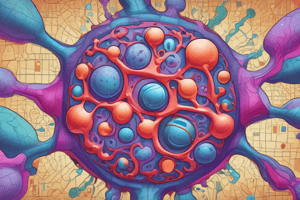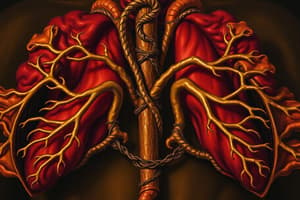Podcast
Questions and Answers
Name the primary lymphoid organs.
Name the primary lymphoid organs.
Thymus, bone marrow
Name the secondary lymphoid organs.
Name the secondary lymphoid organs.
Lymph nodes, spleen, tonsils, appendix, Peyer's patches
Describe the thymus.
Describe the thymus.
Primary lymphoid organ where T cells originate and mature. Prominent in newborns, it increases in size during the first year and gradually atrophies after puberty.
Describe bone marrow as a lymphoid organ.
Describe bone marrow as a lymphoid organ.
Describe the lymph nodes.
Describe the lymph nodes.
Describe the spleen.
Describe the spleen.
What is the function of primary lymphoid organs?
What is the function of primary lymphoid organs?
What is the function of secondary lymphoid organs?
What is the function of secondary lymphoid organs?
What is MALT? List its major components.
What is MALT? List its major components.
Study Notes
Primary Lymphoid Organs
- Thymus and bone marrow are the primary lymphoid organs.
- Thymus is crucial for T cell development; is prominent in newborns and increases in size during the first year, then atrophies after puberty.
Secondary Lymphoid Organs
- Lymph nodes, spleen, tonsils, appendix, and Peyer's patches are classified as secondary lymphoid organs.
- Secondary lymphoid organs activate lymphocytes and filter extracellular fluids.
Thymus Characteristics
- Functions as the maturation site for T cells; does not directly fight antigens.
- Structure reduces in functionality and size with age, becoming fibrous and fatty in old age.
Bone Marrow Functions
- Red bone marrow serves as the origin for both B and T cells.
- B cells mature in bone marrow, while T cells migrate to the thymus for maturation.
Lymph Node Structure and Role
- Composed of B cells, T cells, macrophages, and dendritic cells.
- Filters lymph from body tissues and presents antigens to activate the immune system.
Spleen Overview
- Largest lymphoid organ, crucial for lymphocyte proliferation and immune surveillance.
- Contains white pulp for immune function and red pulp for filtering aged and defective blood cells.
- Stores platelets and monocytes, releasing them when needed, and filters blood—contrasting with lymph nodes, which filter lymph.
Primary Lymphoid Function
- Primary lymphatic organs are vital for the formation and maturation of lymphocytes, specifically B and T cells.
Secondary Lymphoid Function
- Monitor extracellular fluids including lymph, tissue fluid, and blood.
- Sites for lymphocyte activation and include lymph nodes, tonsils, spleen, Peyer's patches, and appendix.
MALT
- Mucosa-Associated Lymphoid Tissue refers to collections of lymphoid tissue in various locations, including tonsils, Peyer’s patches in the small intestine, and the appendix.
Studying That Suits You
Use AI to generate personalized quizzes and flashcards to suit your learning preferences.
Description
This quiz covers the primary and secondary lymphoid organs in the human body. Learn about the functions and characteristics of the thymus, bone marrow, lymph nodes, and more. Perfect for students in immunology or biology classes.




